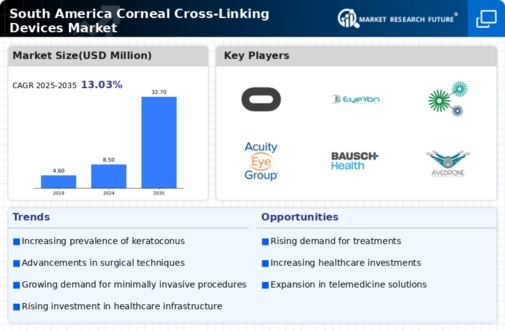The South America Corneal Cross-Linking Devices Market is experiencing considerable competitive dynamics, driven by advances in technology, increasing awareness of eye health, and the growing prevalence of corneal diseases such as keratoconus.
The market is characterized by the presence of both established players and emerging companies that are actively working to enhance their product offerings and expand their market reach.
Innovations in cross-linking technology, efficacy and safety profile of devices, regulatory approvals, and strategic collaborations between manufacturers and healthcare providers are among the key factors influencing competition.
Furthermore, the demand for minimally invasive procedures has encouraged companies to invest in research and development of more efficient corneal cross-linking solutions tailored to the specific needs of the South American populace.
Oculus is a prominent player in the South America Corneal Cross-Linking Devices Market, recognized for its commitment to providing innovative ophthalmic solutions. The company's product offerings in this market are marked by advanced technology and a solid reputation for quality, which has enabled it to establish a significant presence within South America.
Oculus's strengths lie in its continuous investment in research and development, ensuring the introduction of cutting-edge devices that meet clinical needs. The brand has developed strong relationships with ophthalmologists and clinics, facilitating widespread adoption of its corneal cross-linking systems.
As demands for effective treatment options grow, Oculus's ability to deliver reliable and advanced technology positions it as a competitive force in the market landscape. EyeYon Medical is notable within the South America Corneal Cross-Linking Devices Market, focusing on developing innovative solutions for corneal treatment.
The company's key offerings include advanced cross-linking devices that leverage proprietary technologies to enhance treatment outcomes for patients. EyeYon Medical has established a strong presence in this region, bolstered by its commitment to quality and efficacy in its product line.
Strengths of the company include its research-driven approach which has led to successful innovations in corneal therapies, providing a competitive edge. Additionally, EyeYon Medical has engaged in strategic collaborations and partnerships within South America to expand its market footprint.
This includes potential mergers and acquisitions aimed at integrating complementary technologies and increasing its market share. The company's focus on developing specific products for the South American market reflects a strong understanding of regional needs and opportunities, further cementing its competitive stance.




















Leave a Comment